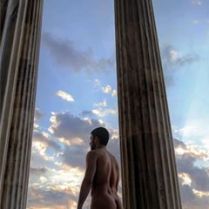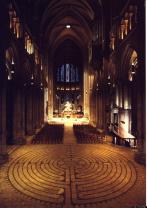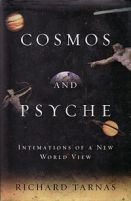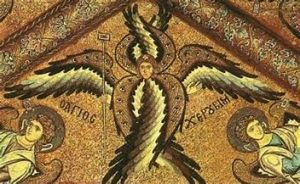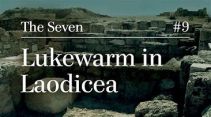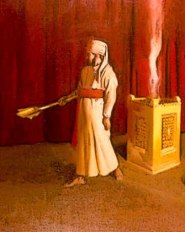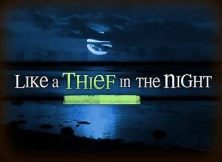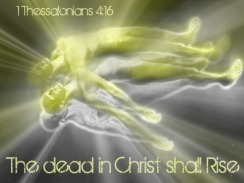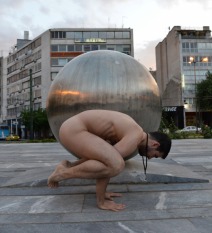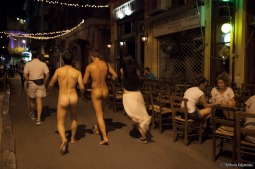WELCOME TO THE SPIRITUAL SYMBOLIC LABYRINTH
Religion mostly deals in absolutes. Art, which is often in trouble with religion, deals in the grey areas. But both religion and art are joined in their connection to leading, life-governing symbols. This article will conduct the reader through a veritable labyrinth of symbols towards an unexpected, quasi-apocalyptic message with links past and present to a biblically celebrated Greek city. Be patient to discover and arrive.
Later this year an arguably misnamed film, The Changing of the Gods, based on the work of Cosmos and Psyche by culture historian Richard Tarnass, should be making irrefutably clear how much events follow cycles. It will demonstrate what’s ignored by scientists and Christians (the latter despite the Magi and all the statements of Ecclesiastes to the effect was has been will be), namely that as many people have long known, the course of wars, revolutions and social change generally, really does follow distinct planetary patterns. And these engage specific symbols.
Symbols are distinctively one thing or genus (like the Mars long associated with war and mayhem), but they are also multivalent, not just war but a gun and sword, and then they have positive and negative expressions too as when Mars is associated with courage and decisiveness and not just strife.
At this point in history we are moreover on the cusp of two ages – that of Pisces “ruled” by Neptune and that of Aquarius “ruled” by Uranus. Accordingly, if we are at all sensitive to the flow of events, we can observe and are experiencing an often confused, half merged, clashing overload of Neptunian and Uranian symbols and themes.
On the Piscean side we have the Neptunian victim, refugee, suffering, compassion, inclusivism at all costs, a certain domination by film, image and dreams, also lies and corruption, drugs and addiction, permissiveness and mysticism in all shapes and sizes, good and bad.
On the Aquarian side, there is an obsession with personal rights, autonomy, difference and gayness. There is a disposition to shock, to revolution or group action and thus recourse to social media, also to achieve “perfection “ (at least of bodies), a tendency to domination by technology and abstract dogmatism, an orientation to future trends and Utopias (more “perfection”).
There is no need to enumerate the potential for positive and negative expression within the signs and their trends. It should be obvious. Sometimes Neptune and Uranus seem to complement one another as when Neptune is nature and Uranus is society, sometimes they suggest absolute polarities as when Neptune is sleep and dream, and Uranus is wakefulness and inspiration,. It is these polarities, natural and social, sleep and awake, which are also biblically stressed polarities and with an odd connection to the issue of nudity that I shall be stressing here even as reaching into a sign of the times worth noting.
We can return to the point and related matters presently, but here is one of the relevant, symbolically loaded biblical statements which may not mean quite what it seems. And it is problematic, not just for what it might be thought to imply about sex, shame and nudity, but because of its odd comparison, one we need to understand, of the Christ of the apocalypse with a thief. …… “See I am coming like a thief! Blessed is the one who stays awake and is clothed, not going about naked and exposed to shame” (Rev 15:16).
IT ALL DEPENDS WHAT YOU THINK AND SEE
Nudity is all of a mixed signals symbol. It is what especially postmodernists might call a floating signifier. To many, even or especially in the permissive west, nudity signifies little more than having sex or being immodest or aggressively exhibitionist (as in streaking). Some laws may still treat nudity under the head of “indecent exposure” or “public nuisance”, a virtual crime (even if victimless) rather than anything that might involve art, a special statement or a lifestyle option. The fact is the condition proves elusive when it comes to defining quite what it represents and does. Assumed to be sexual, for some it may seem less erotic than the effects produced by the behaviour of an individual fully clothed.
Sociologically, the nothing-but-sex reaction is more in evidence where there is less gender equality and/or women are – as in Hollywood! – just objects to men. Thus in relatively egalitarian Scandinavia nudity is not a big deal with families sharing naked sauna. In other ages and climes, and famously in ancient Greece, it was rather men than women who had the right to be naked, (though not necessarily as an object for women who could be executed for observing the nude games!). And before the Christian West unexpectedly made something of a standard artistic fetish of the female nude, it was male nudity was more portrayed. Symbolically there was a sort of natural correctness to this. As in medieval alchemical art, the male organ , anyway outside the body and thus quasi exposed, is “solar” as against the more hidden, “lunar” female genitals .
Where sex is not the sole association, nudity can symbolize protest and especially freedom from conventional personal and societal images such as clothes impose. The purely legal or morals campaigner approach ignores that and risks compromising a type of sincerity and signification, including even biblically. St Francis did a holy striptease in the street in rejection of his father’s lifestyle and source of wealth as a cloth merchant and to make a point he preached a sermon in the nude. The prophet Micah, who sounds like the nearest thing to a Jewish Diogenes (the Cynic Greek philosopher who lived naked in a tub) declares he will go stripped and naked and wailing like the jackals (Mic 1:8). Isaiah went about “naked” as a sign for three years (Is 20:2-4}. Quite how naked he was is not clear, but denying his aristocratic status, it seems he went about slave-like at least buttocks bared as a warning of impending captivity.
OPEN TO THE ETHERS AND THE HOLY ?
Signs and protests apart, Isaiah and Micah could hardly go far wrong because it is affirmed we are all naked before God anyway ( Heb 4: 13) and, at least symbolically, are even meant to be perhaps especially in relation to worship. In some paganism like wicca, nudity is not symbolic but overt and in order, it’s believed, to free connection of the aura/soul body to the elements to increase spiritual power. It’s an idea that possibly obtained among Israel’s early school of the prophets given the statement that King Saul was thought to be like the prophets because he had stripped off and lain naked like them all night (1 Sam 19:24). The Rev Charles Kingsley (author of The Water Babies) was puzzled by the fact he felt more spiritual when unclothed. I have now and again noticed individuals as on youtube express surprise at having received major inspiration, even messages from God while showering. Maybe they shouldn’t be so surprised.
Though most systems and persons are less radical than wiccans and less sensitive than KIngsley, and while nudity may have its spiritual uses, no religious system outside the Jains has deemed it essential. Even so and in Judaism, its priests, though dressed for temple service, must still go bare foot. Famously Moses must remove his shoes before the burning bush. Beyond just reverence, this is very likely to signify the humility and honesty of a symbolic nudity because, as any rabbi will tell you, the feet are often a biblical symbol/circumlocution for the genitals. It is even widely believed that Isaiah’s cherubim, whose wings cover their feet (Is 6:2), is circumlocution for covering their genitals….In which case, this begs the question why would God require a symbolic nudity for priests if the celestial realms of the cherubim have no room for an actual nudity among those perfect, unfallen beings?
Though you could explore this difficult, sensitive subject through Jewish works like God’s Phallus by Howard Eilberg-Schwartz, in brief parenthesis I will supply one answer here and particularly as Christianity with its doctrine of God as Trinity has a special problem with, or clue to, the question if you at all accept as starting point what it took the pornographer Henry Miller to point out. He opined that the penis is like a Trinity symbol with its shaft and two testicles (1) (He didn’t get theological about the female genitals, but one could theorize they represent either another version of the uniplural principle or else they symbolize earth, the All that receives the divinity). What we do know of God is that, as per Ezekiel (Ez 1:27), below the waist he is pure (creative) fire. Sex and the genitals would always be a reflection of that. The lovers of the Song of Solomon are understood to be in the fires of Yah. And we may assume that in some form or other the angelic orders experience this fire – how else could the fallen angels of Genesis have intercourse with women on earth if they were totally sexless?
It follows that, almost as a point of what one could call erotic etiquette, i.e. from respect rather than shame, angelic beings closest to deity are seen as not presuming to expose themselves as though in rivalry to the prime source – the likely reason they also cover their faces is not to rival the divine image). Even on the human plain some of the offence or shock of nudity can be involved with the fact the genitals do not so much belong to the principle of beauty with which the body gets identified as with a more alien, numinous element of power. This applies as much to the female as to the male and is presumably what is being conveyed, however grotesquely, by the peculiar medieval inclusion in churches of the Sheela-na-gig carvings, vestiges of ancient fertility goddesses. (But note that as compared to the more naturalistic depiction of male nudity over the centuries, the Sheelas have, or draw attention to, an exaggerated, unnaturalistic vulva probably because the attempted power emphasis runs somewhat counter to what I have called the more hidden “lunar” aspect of female being).
REVISING THE EDENIC SHAME. WHAT WAS AND IS IT?
Biblical Hebrew has a variety of words and expressions for naked and in translation, sometimes even in Hebrew itself, it is not always perfectly clear what is meant. It could be anything from full nudity to merely being without over garment – situation would indicate. Sometimes the use of nudity can be a precious circumlocution for having sex as in Leviticus where “uncovering the nakedness” means having intercourse, a fact that reminds us the Genesis curse on Ham who saw his (inebriated) father naked, is almost guaranteed to signify a case of incestuous shame rape. However, the nearest root meaning if not translation of naked is usually impoverishment, a certain lack or loss or absence of something, anything from personal power to wealth. Obviously the nakedness of Isaiah was involved with prophetic warning of coming defeat and reduction to slave status.
Yet if there can also be, as in some art forms or the Song of Solomon, something glorious about the naked body, especially if it’s believed to be any “in the image” reflection of the divine, how can and does our floating significator manage also to be shameful? And is it, strictly speaking, sexually/erotically shameful after all? Obviously age, disease and obesity can ravage the body to the point it recalls the all too human “fallen” condition rather than anything sublime, but I don’t think that the idea of shame is principally involved with just that.
In a previous article on my other site (See: Issues of Love, Sex and Biblical ‘Incoherence’ https://wp.me/p2v96G-111) I mentioned that the bible implies a belief in the soul/aura – some passages don’t even make sense without assuming it. I suggest that loss of the aura’s visibility, its radiance around the body that a few psychically inclined persons can still observe, is what the original shame was believed to be. After all, without some loss of the kind happening, how would the Edenic couple sense and observe they were naked in the first place? “Who told you you were naked”? is indeed the question to be asked.
The philosopher Schopenhauer may also provide another clue here. He remarks somewhere that the shame of nudity is involved with the sense of mortality (such as the Genesis story very much points to). The genitals are no longer just part of a bodily whole or a reminder of pleasure, but rather a reminder of the need to procreate against undesired death.
I should say too that if the aura is not observed, it becomes easier for people to forget that one makes love not just to bodies but souls; and then the body without any apparent radiance is more obviously object and thus easily object of a dissociated lust that can embarrass and more.
LOSS AND GAIN, WORLD AND LAODICEA
So at this point we arrive at paradox. For some people in some contexts to be naked is to gain or regain something – one’s being, one’s pure self (i.e.freed of social expectations and without the props and often false signals of clothes), and more in tune with a sensed (aurically based) connection to nature and the All. At the same time, this gain still suffers the effects of all that’s entailed on account of the soul/aura’s invisibility. Even if the naked person may sufficiently reach self harmoney, others not appreciating this may reduce the person to the status of object only or question their honesty, so that in society’s eyes, they are regarded as merely rebellious, eccentric, exhibitionist, perverted etc.
It is thus a win/lose situation for the individual. Even so, above and beyond this and on the cultural plain, we almost certainly need to be rid of notions many easily hold and the bible can be thought to point to, but doesn’t automatically , that nudity is shameful or embarrassing per se, that it equates with sex only and lewdly so. Relevant here are words to the church of Laodicea in the book of Revelation. The church is the last addressed of seven churches of Asia Minor, and although the relevant community did exist and was still active to shape church policy into the fourth century, the churches are often seen as symbolic and prophetic for church history with Laodicea representing an end of age decadent religiosity. Historically, Laodicea was a prosperous city famed for luxury goods including a precious eye salve. The church shared in the general prosperity. It also drank from the well-supplied but tepid, lukewarm waters of the region.
Accused of boasting of a wealth they feel renders them invulnerable “we have need of nothing” (is it possible these believers anticipate today’s prosperity gospel advocates?! ) the Laodiceans are told in reality they are “wretched, pitiable, blind, poor and naked”. They are counselled to buy gold from Christ in order to be truly rich, “and white robes to clothe you and to keep the shame of your nakedness from being seen and salve to anoint your eyes so that you may see” (Rev 3:18). What is the shame of nakedness best not seen? Plainly it’s what nudity had broadly symbolized in Hebrew, namely a degree of poverty or loss, a state the Laodiceans fail to realize is theirs no matter how fashionably attired and materially wealthy they are. But why must they acquire white robes to hide the shame of what is their “naked” spiritual poverty in fact?
THE TEMPLE THIEF
In Revelation the redeemed who are seen as like priests unto God (Rev5:10) are said to wear white robes, doubtless because priests of the temple wore white robes. To be frank about it, heaven itself could be dull and impoverished if the redeemed could never get beyond wearing a single garment, however precious, of one colour for all eternity! So the meaning is virtually guaranteed to be otherwise. The reason the priests wore white while their feet were bare was because their white robe represented the lost and to be reacquired radiance of the original, body-surrounding aura which of course could also be coloured but white is the source colour and light itself.
The bible, not least Revelation and apocalyptic themes, is saturated with temple symbolism and theology, though it is only recently being acknowledged and studied quite how much so. We can now return to the earlier mentioned thief in the night passage. What does it mean to say Christ comes as a thief in the night (something he surely can’t be ) and so one needs to keep awake not to go about naked?
The answer is that Christ is being identified with the chief of the Temple guard composed of levite priests whose leader was called the thief. It was as good as sacrilege for selected priests to fall asleep on any night of duty. If they did, the shame of their failure risked being marked out by “the thief”, in effect a clothes thief , who set the offender’s robe alight so that to protect himself he would need to fling off his garment and flee the scene naked. All sorts of symbolism is involved here but most obviously fire represents the judgement and purifying force of deity and the priest is symbolically judged, sent to hell. And if we identify his ritual robe with the aura lost at the fall, then a second death or fall is imaged. I reserve to note another important way in which Christ is symbolically “thief” related. (2)
But we must also remember especially the following point of symbolism as regards sleeping and waking. No matter how pure, free, natural or healthy the nudity of any Christian St Francis, pagan Diogenes or poetic Walt Whitman might be at a certain level, symbolically (even or especially for traditional symbolic systems like astrology), nudity still equates as much as for Hebrew with some kind of loss, lack, even poverty (Francis and Diogenes were both devoted to it).
ASLEEP AND AWAKE, NAKED AND CLOTHED
Symbols are multivalent and like notes they have octaves. It’s thus that, depending on the context, Neptune can signify not only poverty and nudity but film, dream or sleep – recall how much nudity features not only in film but dreams – it’s a commonplace people dream they are suddenly naked in public. It follows that nudity as linked to sleep and dream is also a lack of sorts in relation to its Uranian polarity of wakefulness. The latter can also be identified with knowledge, not like Neptune knowledge of unconscious nature but conscious “enlightenment’ in relation to being, the more archetypal, utopian, celestial plan of things.
We can now better see what is happening with biblical and especially apocalyptic imagery. The state of nudity risks engaging a shame related less to eros and sex than symbolically the condition of sleep which is oblivious to and unprepared for what is to happen. It is confused slumber as against enlightenment, a kind of sleepwalking confusion that characterizes the end of the Neptunian age of Pisces which will suffer the Uranian shock of the coming Aquarian age (which can be equated with the biblical Millennium) with its potential to fulfil among much else the Uranian concern with the improved, perfected body, biblically the immortal one (it is also seen as snatched Ganymede-like to heaven, a thoroughly Uranian and air sign theme in itself).
In the classic, most cited statement regarding the end of age and the so-called Rapture event that precedes the end and disappears the believing prepared, St Paul to the Thessalonians makes the whole subject one of precisely day against night, being awake rather than asleep:
“But you beloved, are not in darkness for that day [the day of the Lord, the Rapture] to surprise you like a thief, for you are all children of the light and children of the day; we are not of the night or of darkness. So then let us not fall asleep as others do, but let us keep awake and be sober” ( I Thess 5:4-6).
Nothing of the naked/clothed polarity explicitly enters in Thessalonians and at one level it needn’t. The omission can even seem positive if one questions what is often felt to be a biblical penchant for anti eros and mere body shaming. But life is stranger than fiction and symbolism has almost autonomous powers, works in chains of association enforcing something like the Jungian compensation factor. Try to leave out the clothed/unclothed equation and what among other things does the end of the age produce but….nudity in or from of all places St Paul’s apocalypse-associated Thessaloniki?
URBAN NUDISM
Urban nudism names the practice, (or claim to be able to practice) a more public nudity. It is and remains more or less illegal, though laws may not be strongly applied in some places and times especially protests and festivals like the World Naked Bike Ride or Gay pride. In several countries it is more or less legal (Denmark and Netherlands, and actually legal in Spain where the freedom was locally curtailed after it was alleged prostitution in Barcelona was exploiting it – inevitably however it was mostly men were seen about town where they functioned as curios for tourists. Because what is Neptunian insinuates rather than rebels and organizes like Uranus, there never has been nor will be any aggressive or highly organized naked revolution akin to Gay Lib but there can be local trends and movements that favour greater freedom.
Harmonious with the symbolism so far mentioned and which includes the idea of poverty, we find urban nudism, the will or desire towards it, enjoys some association with societies either passing through major economic problems like Argentina, Spain and Greece, or societies more prosperous like California’s, but which include a partly ghettoed, less prosperous, alternative lifestyle minority such as gays in San Francisco or Berlin. I recall a TV interview with a Buenos Aires urban nudist who maintained that as he was anyway poor, unemployed and excluded, why not go naked when he had nothing to lose? In San Francisco the pioneer of urban nudism, Naked Guy Martinez, was a university student with radical leftist interests and little cash.
THESSALONIKI’S LATEST “PUBLIC FIGURE”
In politically troubled Greece and since 2014, apart from a celebration of the World Naked Bike Ride in that year and the mayor himself posing nude in support of gay rights and pride, urban nudism is chiefly the property of the not so impoverished artist and architect, Giannis Maskidis (John Mask to his English language followers). Almost certainly it is under the cover of “art” and helped by something approaching a model’s body, that JM has got away without cover of clothes in a conservative society that nonetheless remembers and cherishes its more body free ancient past.
With events like World Naked Bike Ride and Gay Pride it’s collective and annual only, but with JM it’s individual and almost a case of “we see him here, we see him there, he’s mostly naked everywhere” – in parks, under Corinthian columns, draped on statues, posed on balconies, standing on church roofs, in front of altars and icons (though that may be photo-shopped), crawling around art galleries on a dog’s lead (does he want to reproduce Diogenes the Dog?), riding a fairground carousel, doing just about everything but not riding the public transport like a German youth in Berlin. GM’s programme started in his home town of Thessaloniki and spread to Athens and the Greek islands.
But apart from holiday brochure-like suggesting “follow your myth in Greece”, is there any message? Is the chief aim, fame, freedom, art, health, political protest, a neo-pagan campaign, gay pride (JM is gay)? Gayness and its celebration is often accused of precisely exhibitionism or glorification of the body. To the extent that’s valid it would seem inevitable because if the esoteric formula is correct that gays are a female soul in a male body (or a male soul in a female one for lesbians), the body expresses and certifies who the person is more strongly than it does for others. For JM “art” seems the main justification if not quite the main aim. Pictures of nudity often alternate with images of architecture, some of them desolate and almost mournful like some of the comments such as on death being a companion on this or that day or the day requiring one live and suffer.
JM reports the priests hate him (unsurprisingly given that one pic is posed before an altar and extravagantly declares ‘religion spoils everything”!). But given how political, censorious and recently homophobic Orthodoxy – especially its Russian version can be – see my poem Icon World https://wp.me/p2v96G-cs – it is surprising, if wise, clergy have remained more critical than litigious. Orthodoxy is a liturgically exquisite but peculiarly static, monolithic, unprophetic faith that relates almost more to icons and saints than God. And the way its icons deform the human body denying it all Solomonic or Renaissance glories, was perhaps bound by a massive act of psychic compensation, to produce alternatives at the first modern opportunity. But JM’s beliefs are odder than any icon – in one article I can’t and needn’t bother to retrace, he endorses a popular underground piece of neo-mythic philosophy that regards God as by chance excreting human beings rather than making any being “in his image”.
STARTING AT NIGHT
Although JM’s “protest” against the norms may have arisen from a walk in the park in 2013, it can be said to have been birthed, trialled and first filmed for public consumption in 2014 when there were night walks on main roads and past restaurants of central Thessaloniki, evidently to test the waters and loosen up attitudes. Originally we see bag, clothes and camera carrying women supported the venture, something I wouldn’t explain by faghagism towards the two gays involved, but more likely something characteristically Greek. Greece has never quite accepted contemporary feminism which was not long launched before the then Arianna Stassinopoulos produced The Famale Woman which stressed any reforms would need to be for an equality in difference she saw under threat (as would often prove true). I suspect therefore that original support for JM has some connection to a local will to (re)assert threatened principles of phallos by the same society that anciently displayed herms at house entrances.
It is however a coincidence of symbols and their timing that I should wish to stress. It was observed that we are currently at the end of an era, the Piscean whose Neptunian range includes and even exaggerates like the last flare of a candle at era’s end, such things as image, film, photography vulnerability,sleep, the dream, what’s natural including nudity. So it is hard not to notice that the nude protest is birthed towards era’s end at night and at a time which due to a tetrad of blood moons of Jewish festivals in 2014 and 15 caused a particular obsession in some circles with precisely end of days, end of era speculations. (Although there was a lot of exaggeration and misinterpretation about this, I accept the blood moons were an element within larger patterns and cycles and considerably involved with the growing movement towards the building of a third Jewish temple, a potentially apocalyptic, end of days subject indeed).
With so much involved, one cannot usually be either fully for or against nudity. (Unless you are a morals campaigner, solicitation and commercial treatment of nudity are what seem most legally relevant). However, “For everything there is a time/ season…..” says Ecclesiastes (Ecc 3:1) in what is almost a statement of astrological theory and its principle of cycles. In line with this it easier to state whether the kinds of nudity practiced and portrayed, advocated and tolerated are socially and culturally timely.
TOWARDS WHICH LIGHT?
Curiously enough, what has begun in Thessaloniki, the same city to which St Paul conveyed secrets of the end of days, is in its way very timely, though more by way of a counter sign. It begins at night (“we are not of the night” says the apostle) and it progresses into the light of day when not as a game and joke, through a struggle with “dog days’ including with thoughts of death and decay and a kind of meaninglessness which disbelief in deity (or any ideal one) engenders. The emphasis is at variance with futuristic Uranian type concern with the perfected body, the body electric, the body of light or biblically the immortal and resurrected body that gets associated with the Thessalonian teaching of Rapture and the coming age.
As said, neither of the two letters to Thessalonians mentions nudity after the manner of Revelation, but they might as well do so because we know that the asleep/awake polarity that haunts end of the age teachings naturally embraces the clothed/naked polarity also.
It would be misleading to present JM as some kind of unique anti prophet. He belongs to and arises out of his times and unknowingly enacts something within the collective unconscious and between nudity and gayness undeniably engages Neptunian and Uranian themes to a degree as do perhaps the parading and celebrating citizens of Thessaloniki more generally. The Laodiceans that the Christ of Revelation accuses of a shameful nakedness were not literally naked and their species of nakedness was spiritual rather than material.
In the same way, arguably JM’s clerical critics in Thessaloniki and beyond it, could be deemed as naked as he himself is in relation to the times, which is to say both parties are half slumbering, unawakened to, or sleepwalking amid the events and ideals, symbols and beliefs including in relation to the body and attitudes to it that must change with era’s. change. (If that sounds a heavy put on it seems undeniable that JM has ignored all the big issues of his nation – the national debt, chronic unemployment, near destitute pensioners, the migrant flood, the wild fires, the weather etc and it’s not much different with the highly conservative national church ).
So at one level and in the immediate, JM is the original, norms challenging individual, sometimes arty, amusing or just lurid he aims to be. At another level he is a new Everyman who at the end of the era, unconsciously enacts through a key site of Christian origins and prophecy, what is not done, understood or anticipated at a time that calls for heightened awareness and engagement.
I have long claimed to possess the true and still working chart for Christianity (I.e. Pentecost AD 30). The asteroid Thessalia, the only possible and surely correct indicator for Thessaloniki within the pattern is, of all things, in shocking, surprising, “expect the unexpected”, next era Aquarius, and at that in the house of unions which is what the Rapture/Marriage of the Lamb is. And there it’s conjunct, as though in some sort of warning recalling the tone and message of Christ’s apocalyptic parables, The Part of Unpreparedness. All this seems curiously harmonious with the apostle’s words “therefore let us not sleep as others do , but let us watch.” (1 Thess 5:6).
NOTES
1) Some would protest the pornographer’s daring symbolism is inexact because the three elements are not “equal”. Ironically I would insist the doctrine of absolute, geometrical Trinitarian equality which is St Augustine’s and which ultimately split West from East, is misleading. Greek theology, more in line with biblical statements, teaches something closer to semi-subordinationism with both Son and Spirit issuing from the One, a position which, as pointed out in various of my books and writings has implications for how deity, creation and sexuality are to be understood.
2) Another reason that the Christ of Revelation is the night “thief” is because of his associations with Mercury, traditionally planetary symbol of the thief. The occultist Mme Blavatsky was the first to call Jesus Mercury outright and basically because like pagan Mercury he is described as mediator, healer and the go-between in relation to heaven and earth. As it happens however, and despite the fact that messianic Jupiter was “his star”, technically Mercury “rules” Jesus birth because with a Virgo sun and Gemini rising, the ruling factor is necessarily Mercury. These matters are covered in my Testament of the Magi: Mysteries of the Birth and Life of Christ, https://goo.gl/x8KASy . This is the only astrological study, a radical development of the respected D’Occhieppo/Hughes theory of the birth, which proves itself again and again. It still uniquely works to register Christ issues across history to our times – in short, it’s material too hot for many inside or outside religion to handle and is insultingly ignored accordingly.
For further exploration of the theological and sexual see my Solomon’s Tantric Song https://goo.gl/sU21My
